Developing a Tourism Strategy: A Broadstairs Coastal Area Plan
VerifiedAdded on 2023/01/12
|16
|5123
|36
Report
AI Summary
This report examines strategic planning for tourism in coastal areas, using Broadstairs, UK, as a case study. Part 1 explores the benefits of tourism strategic plans, highlighting risk management, natural resource protection, and community improvement. It also evaluates the importance of collaborative planning, discussing its pros and cons, including problem-solving potential and time consumption. Part 2 compiles a brief tourism strategy for Broadstairs, addressing issues like Brexit uncertainty and evolving market trends. It outlines a vision and objectives, focusing on implementation strategies and stakeholder involvement. Finally, it evaluates the strategy's social and economic benefits for residents and visitors, aiming for sustainable development and enhanced tourism experiences. This document is available on Desklib, where students can find a wealth of study resources, including past papers and solved assignments.
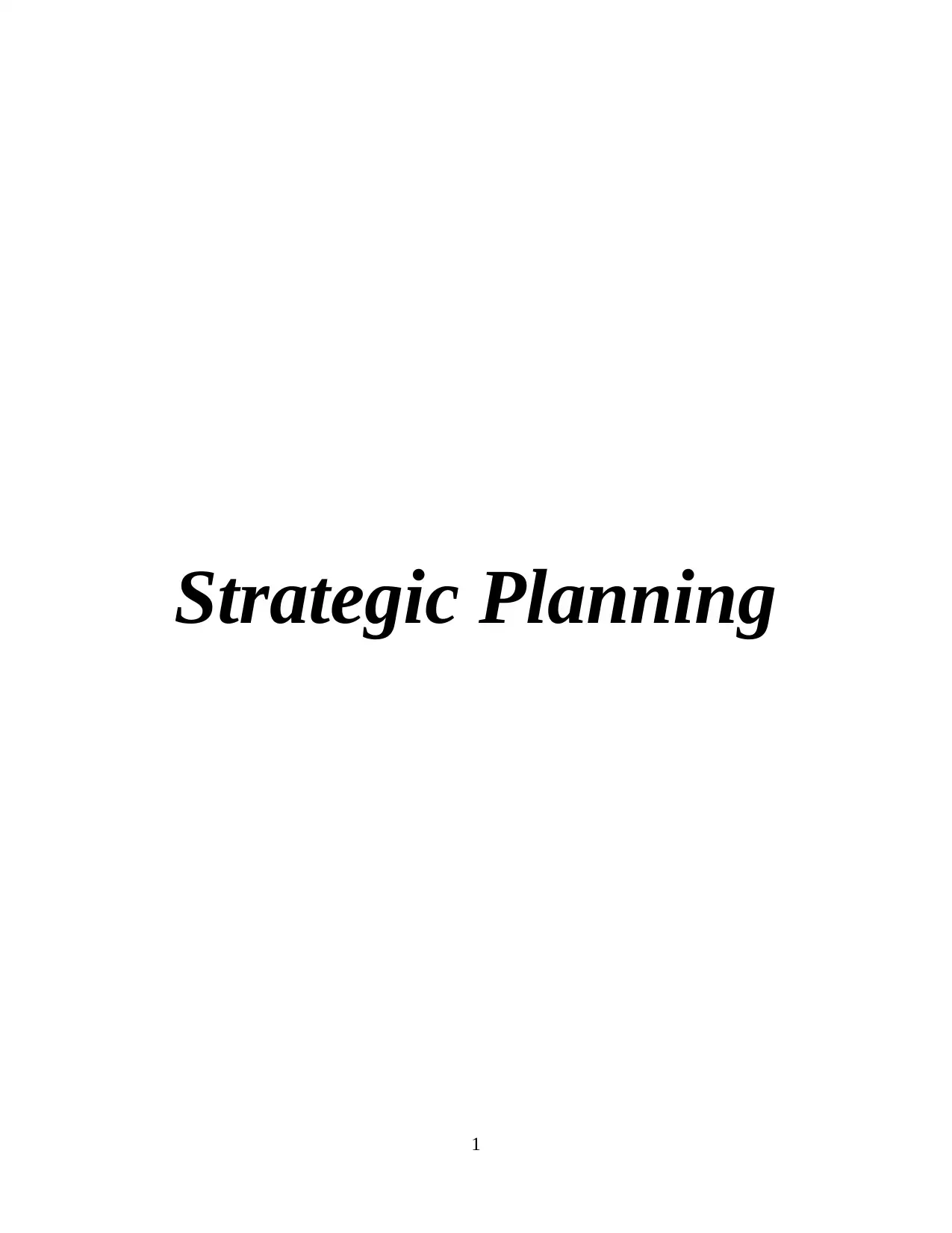
Strategic Planning
1
1
Paraphrase This Document
Need a fresh take? Get an instant paraphrase of this document with our AI Paraphraser
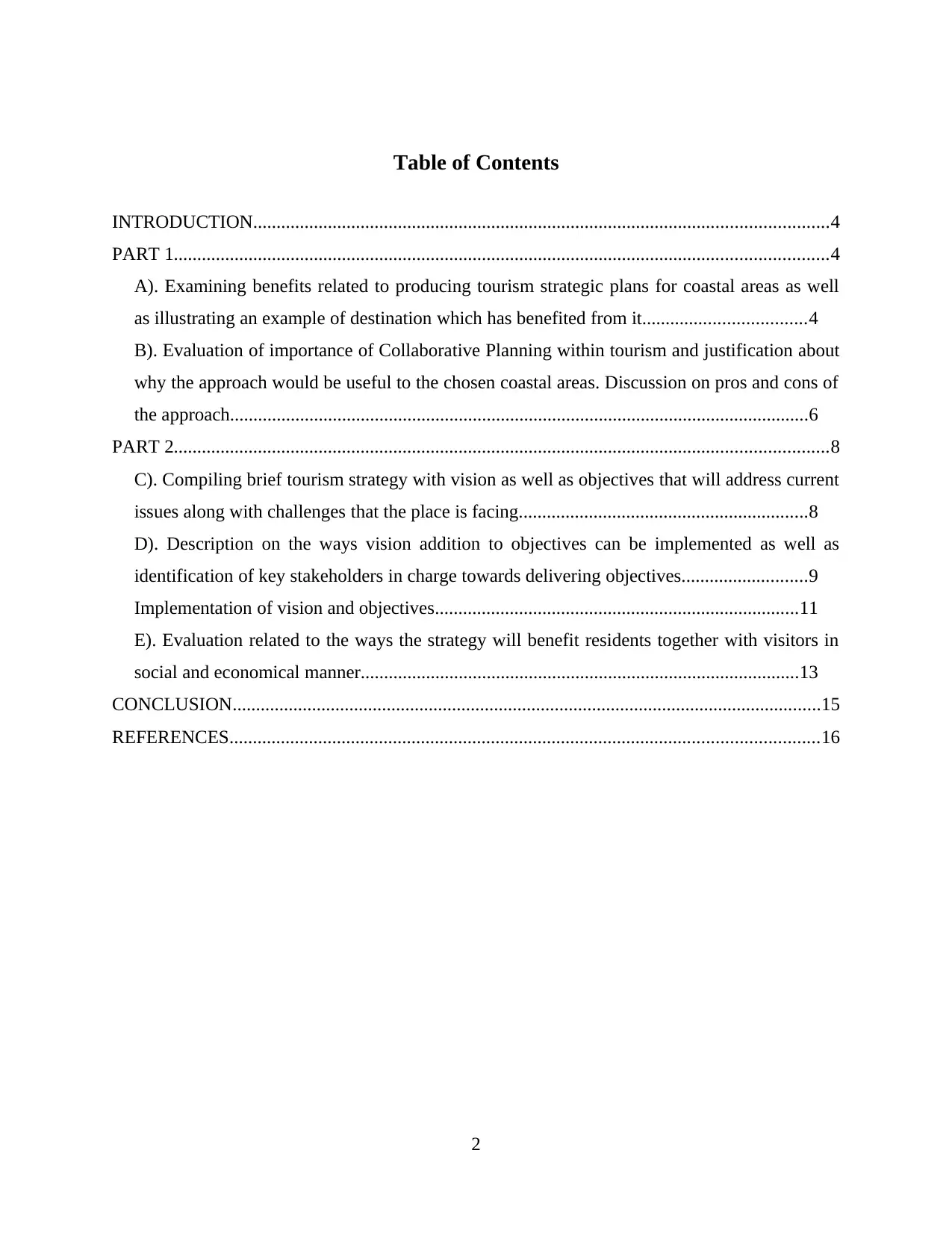
Table of Contents
INTRODUCTION...........................................................................................................................4
PART 1............................................................................................................................................4
A). Examining benefits related to producing tourism strategic plans for coastal areas as well
as illustrating an example of destination which has benefited from it...................................4
B). Evaluation of importance of Collaborative Planning within tourism and justification about
why the approach would be useful to the chosen coastal areas. Discussion on pros and cons of
the approach............................................................................................................................6
PART 2............................................................................................................................................8
C). Compiling brief tourism strategy with vision as well as objectives that will address current
issues along with challenges that the place is facing..............................................................8
D). Description on the ways vision addition to objectives can be implemented as well as
identification of key stakeholders in charge towards delivering objectives...........................9
Implementation of vision and objectives..............................................................................11
E). Evaluation related to the ways the strategy will benefit residents together with visitors in
social and economical manner..............................................................................................13
CONCLUSION..............................................................................................................................15
REFERENCES..............................................................................................................................16
2
INTRODUCTION...........................................................................................................................4
PART 1............................................................................................................................................4
A). Examining benefits related to producing tourism strategic plans for coastal areas as well
as illustrating an example of destination which has benefited from it...................................4
B). Evaluation of importance of Collaborative Planning within tourism and justification about
why the approach would be useful to the chosen coastal areas. Discussion on pros and cons of
the approach............................................................................................................................6
PART 2............................................................................................................................................8
C). Compiling brief tourism strategy with vision as well as objectives that will address current
issues along with challenges that the place is facing..............................................................8
D). Description on the ways vision addition to objectives can be implemented as well as
identification of key stakeholders in charge towards delivering objectives...........................9
Implementation of vision and objectives..............................................................................11
E). Evaluation related to the ways the strategy will benefit residents together with visitors in
social and economical manner..............................................................................................13
CONCLUSION..............................................................................................................................15
REFERENCES..............................................................................................................................16
2
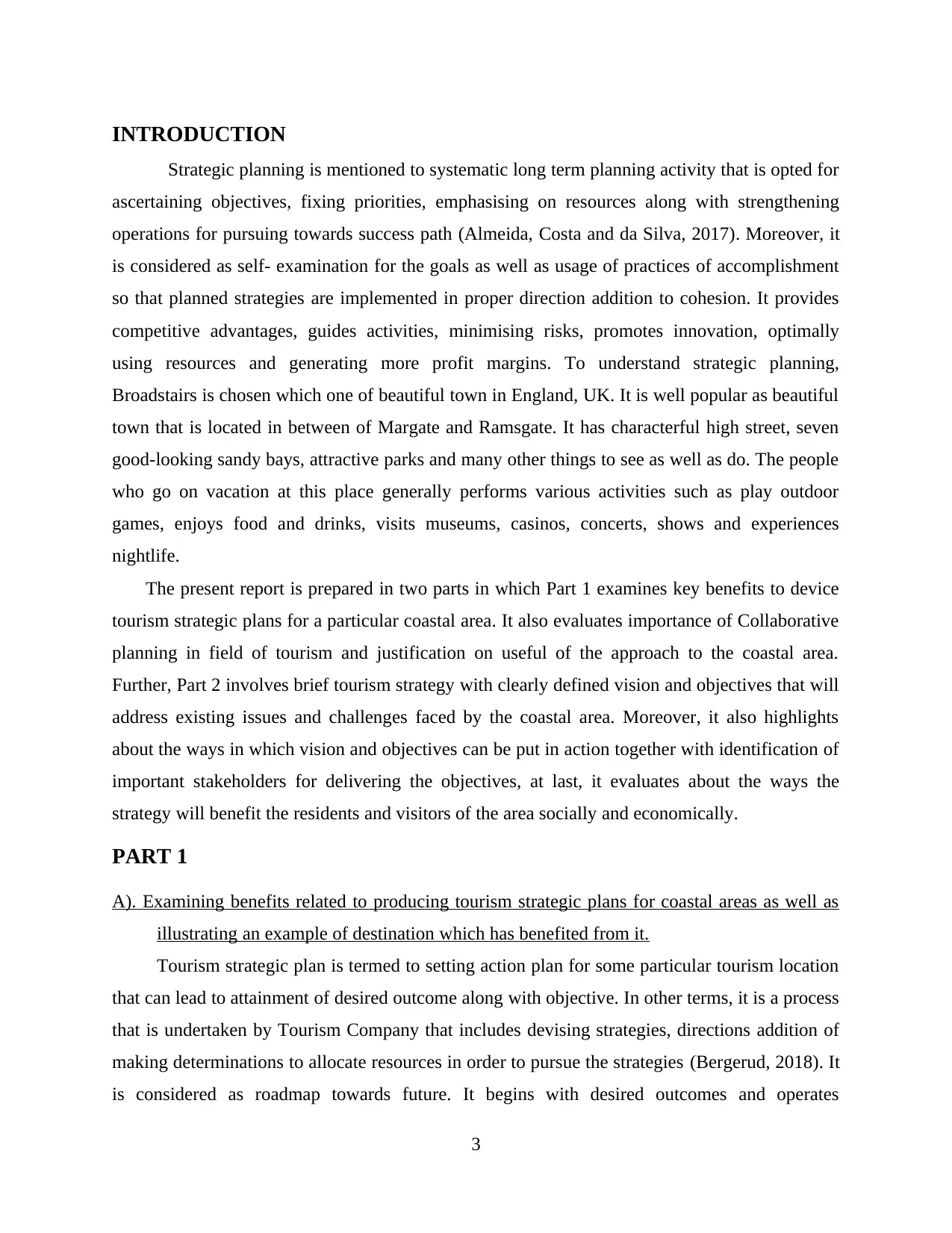
INTRODUCTION
Strategic planning is mentioned to systematic long term planning activity that is opted for
ascertaining objectives, fixing priorities, emphasising on resources along with strengthening
operations for pursuing towards success path (Almeida, Costa and da Silva, 2017). Moreover, it
is considered as self- examination for the goals as well as usage of practices of accomplishment
so that planned strategies are implemented in proper direction addition to cohesion. It provides
competitive advantages, guides activities, minimising risks, promotes innovation, optimally
using resources and generating more profit margins. To understand strategic planning,
Broadstairs is chosen which one of beautiful town in England, UK. It is well popular as beautiful
town that is located in between of Margate and Ramsgate. It has characterful high street, seven
good-looking sandy bays, attractive parks and many other things to see as well as do. The people
who go on vacation at this place generally performs various activities such as play outdoor
games, enjoys food and drinks, visits museums, casinos, concerts, shows and experiences
nightlife.
The present report is prepared in two parts in which Part 1 examines key benefits to device
tourism strategic plans for a particular coastal area. It also evaluates importance of Collaborative
planning in field of tourism and justification on useful of the approach to the coastal area.
Further, Part 2 involves brief tourism strategy with clearly defined vision and objectives that will
address existing issues and challenges faced by the coastal area. Moreover, it also highlights
about the ways in which vision and objectives can be put in action together with identification of
important stakeholders for delivering the objectives, at last, it evaluates about the ways the
strategy will benefit the residents and visitors of the area socially and economically.
PART 1
A). Examining benefits related to producing tourism strategic plans for coastal areas as well as
illustrating an example of destination which has benefited from it.
Tourism strategic plan is termed to setting action plan for some particular tourism location
that can lead to attainment of desired outcome along with objective. In other terms, it is a process
that is undertaken by Tourism Company that includes devising strategies, directions addition of
making determinations to allocate resources in order to pursue the strategies (Bergerud, 2018). It
is considered as roadmap towards future. It begins with desired outcomes and operates
3
Strategic planning is mentioned to systematic long term planning activity that is opted for
ascertaining objectives, fixing priorities, emphasising on resources along with strengthening
operations for pursuing towards success path (Almeida, Costa and da Silva, 2017). Moreover, it
is considered as self- examination for the goals as well as usage of practices of accomplishment
so that planned strategies are implemented in proper direction addition to cohesion. It provides
competitive advantages, guides activities, minimising risks, promotes innovation, optimally
using resources and generating more profit margins. To understand strategic planning,
Broadstairs is chosen which one of beautiful town in England, UK. It is well popular as beautiful
town that is located in between of Margate and Ramsgate. It has characterful high street, seven
good-looking sandy bays, attractive parks and many other things to see as well as do. The people
who go on vacation at this place generally performs various activities such as play outdoor
games, enjoys food and drinks, visits museums, casinos, concerts, shows and experiences
nightlife.
The present report is prepared in two parts in which Part 1 examines key benefits to device
tourism strategic plans for a particular coastal area. It also evaluates importance of Collaborative
planning in field of tourism and justification on useful of the approach to the coastal area.
Further, Part 2 involves brief tourism strategy with clearly defined vision and objectives that will
address existing issues and challenges faced by the coastal area. Moreover, it also highlights
about the ways in which vision and objectives can be put in action together with identification of
important stakeholders for delivering the objectives, at last, it evaluates about the ways the
strategy will benefit the residents and visitors of the area socially and economically.
PART 1
A). Examining benefits related to producing tourism strategic plans for coastal areas as well as
illustrating an example of destination which has benefited from it.
Tourism strategic plan is termed to setting action plan for some particular tourism location
that can lead to attainment of desired outcome along with objective. In other terms, it is a process
that is undertaken by Tourism Company that includes devising strategies, directions addition of
making determinations to allocate resources in order to pursue the strategies (Bergerud, 2018). It
is considered as roadmap towards future. It begins with desired outcomes and operates
3
⊘ This is a preview!⊘
Do you want full access?
Subscribe today to unlock all pages.

Trusted by 1+ million students worldwide
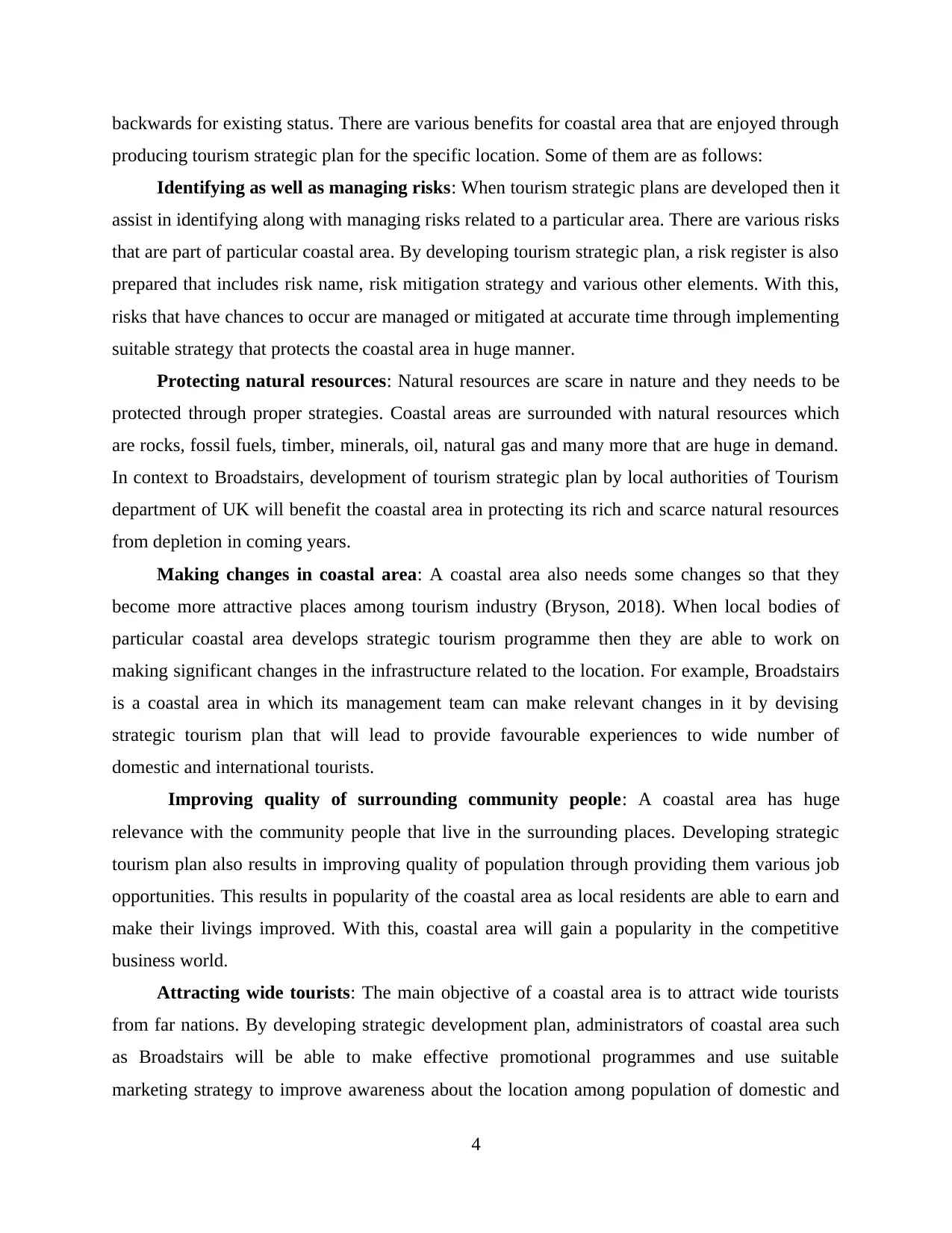
backwards for existing status. There are various benefits for coastal area that are enjoyed through
producing tourism strategic plan for the specific location. Some of them are as follows:
Identifying as well as managing risks: When tourism strategic plans are developed then it
assist in identifying along with managing risks related to a particular area. There are various risks
that are part of particular coastal area. By developing tourism strategic plan, a risk register is also
prepared that includes risk name, risk mitigation strategy and various other elements. With this,
risks that have chances to occur are managed or mitigated at accurate time through implementing
suitable strategy that protects the coastal area in huge manner.
Protecting natural resources: Natural resources are scare in nature and they needs to be
protected through proper strategies. Coastal areas are surrounded with natural resources which
are rocks, fossil fuels, timber, minerals, oil, natural gas and many more that are huge in demand.
In context to Broadstairs, development of tourism strategic plan by local authorities of Tourism
department of UK will benefit the coastal area in protecting its rich and scarce natural resources
from depletion in coming years.
Making changes in coastal area: A coastal area also needs some changes so that they
become more attractive places among tourism industry (Bryson, 2018). When local bodies of
particular coastal area develops strategic tourism programme then they are able to work on
making significant changes in the infrastructure related to the location. For example, Broadstairs
is a coastal area in which its management team can make relevant changes in it by devising
strategic tourism plan that will lead to provide favourable experiences to wide number of
domestic and international tourists.
Improving quality of surrounding community people: A coastal area has huge
relevance with the community people that live in the surrounding places. Developing strategic
tourism plan also results in improving quality of population through providing them various job
opportunities. This results in popularity of the coastal area as local residents are able to earn and
make their livings improved. With this, coastal area will gain a popularity in the competitive
business world.
Attracting wide tourists: The main objective of a coastal area is to attract wide tourists
from far nations. By developing strategic development plan, administrators of coastal area such
as Broadstairs will be able to make effective promotional programmes and use suitable
marketing strategy to improve awareness about the location among population of domestic and
4
producing tourism strategic plan for the specific location. Some of them are as follows:
Identifying as well as managing risks: When tourism strategic plans are developed then it
assist in identifying along with managing risks related to a particular area. There are various risks
that are part of particular coastal area. By developing tourism strategic plan, a risk register is also
prepared that includes risk name, risk mitigation strategy and various other elements. With this,
risks that have chances to occur are managed or mitigated at accurate time through implementing
suitable strategy that protects the coastal area in huge manner.
Protecting natural resources: Natural resources are scare in nature and they needs to be
protected through proper strategies. Coastal areas are surrounded with natural resources which
are rocks, fossil fuels, timber, minerals, oil, natural gas and many more that are huge in demand.
In context to Broadstairs, development of tourism strategic plan by local authorities of Tourism
department of UK will benefit the coastal area in protecting its rich and scarce natural resources
from depletion in coming years.
Making changes in coastal area: A coastal area also needs some changes so that they
become more attractive places among tourism industry (Bryson, 2018). When local bodies of
particular coastal area develops strategic tourism programme then they are able to work on
making significant changes in the infrastructure related to the location. For example, Broadstairs
is a coastal area in which its management team can make relevant changes in it by devising
strategic tourism plan that will lead to provide favourable experiences to wide number of
domestic and international tourists.
Improving quality of surrounding community people: A coastal area has huge
relevance with the community people that live in the surrounding places. Developing strategic
tourism plan also results in improving quality of population through providing them various job
opportunities. This results in popularity of the coastal area as local residents are able to earn and
make their livings improved. With this, coastal area will gain a popularity in the competitive
business world.
Attracting wide tourists: The main objective of a coastal area is to attract wide tourists
from far nations. By developing strategic development plan, administrators of coastal area such
as Broadstairs will be able to make effective promotional programmes and use suitable
marketing strategy to improve awareness about the location among population of domestic and
4
Paraphrase This Document
Need a fresh take? Get an instant paraphrase of this document with our AI Paraphraser
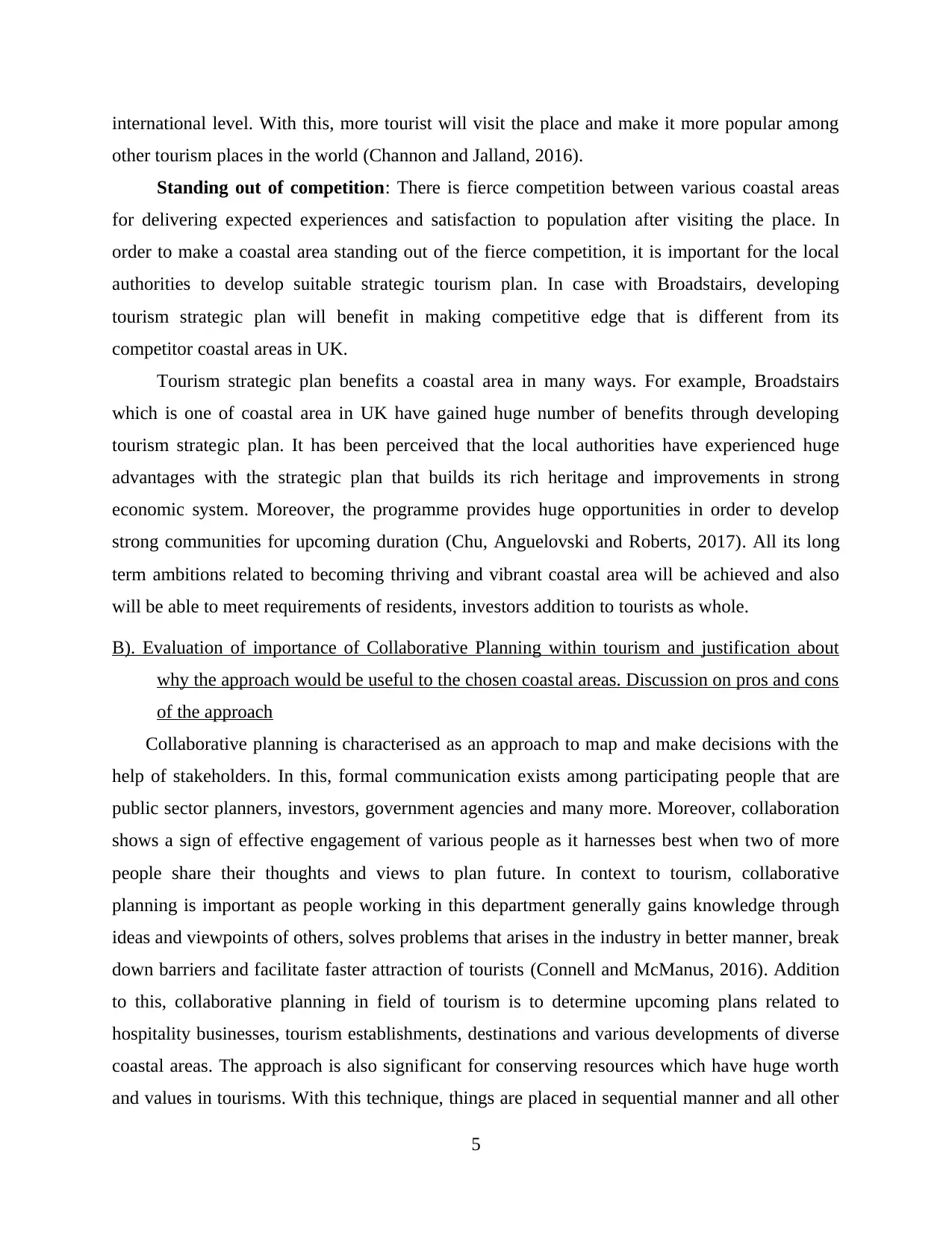
international level. With this, more tourist will visit the place and make it more popular among
other tourism places in the world (Channon and Jalland, 2016).
Standing out of competition: There is fierce competition between various coastal areas
for delivering expected experiences and satisfaction to population after visiting the place. In
order to make a coastal area standing out of the fierce competition, it is important for the local
authorities to develop suitable strategic tourism plan. In case with Broadstairs, developing
tourism strategic plan will benefit in making competitive edge that is different from its
competitor coastal areas in UK.
Tourism strategic plan benefits a coastal area in many ways. For example, Broadstairs
which is one of coastal area in UK have gained huge number of benefits through developing
tourism strategic plan. It has been perceived that the local authorities have experienced huge
advantages with the strategic plan that builds its rich heritage and improvements in strong
economic system. Moreover, the programme provides huge opportunities in order to develop
strong communities for upcoming duration (Chu, Anguelovski and Roberts, 2017). All its long
term ambitions related to becoming thriving and vibrant coastal area will be achieved and also
will be able to meet requirements of residents, investors addition to tourists as whole.
B). Evaluation of importance of Collaborative Planning within tourism and justification about
why the approach would be useful to the chosen coastal areas. Discussion on pros and cons
of the approach
Collaborative planning is characterised as an approach to map and make decisions with the
help of stakeholders. In this, formal communication exists among participating people that are
public sector planners, investors, government agencies and many more. Moreover, collaboration
shows a sign of effective engagement of various people as it harnesses best when two of more
people share their thoughts and views to plan future. In context to tourism, collaborative
planning is important as people working in this department generally gains knowledge through
ideas and viewpoints of others, solves problems that arises in the industry in better manner, break
down barriers and facilitate faster attraction of tourists (Connell and McManus, 2016). Addition
to this, collaborative planning in field of tourism is to determine upcoming plans related to
hospitality businesses, tourism establishments, destinations and various developments of diverse
coastal areas. The approach is also significant for conserving resources which have huge worth
and values in tourisms. With this technique, things are placed in sequential manner and all other
5
other tourism places in the world (Channon and Jalland, 2016).
Standing out of competition: There is fierce competition between various coastal areas
for delivering expected experiences and satisfaction to population after visiting the place. In
order to make a coastal area standing out of the fierce competition, it is important for the local
authorities to develop suitable strategic tourism plan. In case with Broadstairs, developing
tourism strategic plan will benefit in making competitive edge that is different from its
competitor coastal areas in UK.
Tourism strategic plan benefits a coastal area in many ways. For example, Broadstairs
which is one of coastal area in UK have gained huge number of benefits through developing
tourism strategic plan. It has been perceived that the local authorities have experienced huge
advantages with the strategic plan that builds its rich heritage and improvements in strong
economic system. Moreover, the programme provides huge opportunities in order to develop
strong communities for upcoming duration (Chu, Anguelovski and Roberts, 2017). All its long
term ambitions related to becoming thriving and vibrant coastal area will be achieved and also
will be able to meet requirements of residents, investors addition to tourists as whole.
B). Evaluation of importance of Collaborative Planning within tourism and justification about
why the approach would be useful to the chosen coastal areas. Discussion on pros and cons
of the approach
Collaborative planning is characterised as an approach to map and make decisions with the
help of stakeholders. In this, formal communication exists among participating people that are
public sector planners, investors, government agencies and many more. Moreover, collaboration
shows a sign of effective engagement of various people as it harnesses best when two of more
people share their thoughts and views to plan future. In context to tourism, collaborative
planning is important as people working in this department generally gains knowledge through
ideas and viewpoints of others, solves problems that arises in the industry in better manner, break
down barriers and facilitate faster attraction of tourists (Connell and McManus, 2016). Addition
to this, collaborative planning in field of tourism is to determine upcoming plans related to
hospitality businesses, tourism establishments, destinations and various developments of diverse
coastal areas. The approach is also significant for conserving resources which have huge worth
and values in tourisms. With this technique, things are placed in sequential manner and all other
5
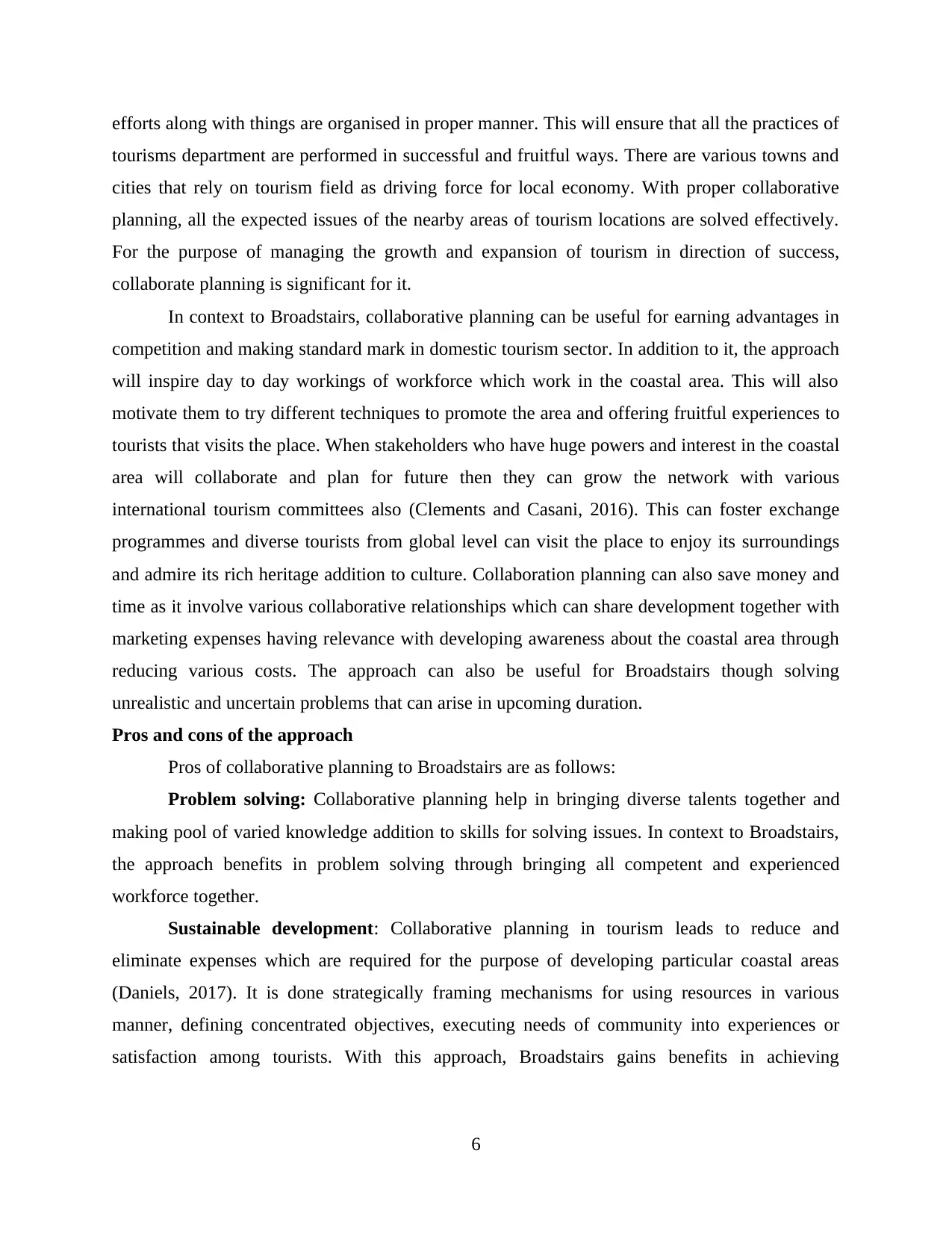
efforts along with things are organised in proper manner. This will ensure that all the practices of
tourisms department are performed in successful and fruitful ways. There are various towns and
cities that rely on tourism field as driving force for local economy. With proper collaborative
planning, all the expected issues of the nearby areas of tourism locations are solved effectively.
For the purpose of managing the growth and expansion of tourism in direction of success,
collaborate planning is significant for it.
In context to Broadstairs, collaborative planning can be useful for earning advantages in
competition and making standard mark in domestic tourism sector. In addition to it, the approach
will inspire day to day workings of workforce which work in the coastal area. This will also
motivate them to try different techniques to promote the area and offering fruitful experiences to
tourists that visits the place. When stakeholders who have huge powers and interest in the coastal
area will collaborate and plan for future then they can grow the network with various
international tourism committees also (Clements and Casani, 2016). This can foster exchange
programmes and diverse tourists from global level can visit the place to enjoy its surroundings
and admire its rich heritage addition to culture. Collaboration planning can also save money and
time as it involve various collaborative relationships which can share development together with
marketing expenses having relevance with developing awareness about the coastal area through
reducing various costs. The approach can also be useful for Broadstairs though solving
unrealistic and uncertain problems that can arise in upcoming duration.
Pros and cons of the approach
Pros of collaborative planning to Broadstairs are as follows:
Problem solving: Collaborative planning help in bringing diverse talents together and
making pool of varied knowledge addition to skills for solving issues. In context to Broadstairs,
the approach benefits in problem solving through bringing all competent and experienced
workforce together.
Sustainable development: Collaborative planning in tourism leads to reduce and
eliminate expenses which are required for the purpose of developing particular coastal areas
(Daniels, 2017). It is done strategically framing mechanisms for using resources in various
manner, defining concentrated objectives, executing needs of community into experiences or
satisfaction among tourists. With this approach, Broadstairs gains benefits in achieving
6
tourisms department are performed in successful and fruitful ways. There are various towns and
cities that rely on tourism field as driving force for local economy. With proper collaborative
planning, all the expected issues of the nearby areas of tourism locations are solved effectively.
For the purpose of managing the growth and expansion of tourism in direction of success,
collaborate planning is significant for it.
In context to Broadstairs, collaborative planning can be useful for earning advantages in
competition and making standard mark in domestic tourism sector. In addition to it, the approach
will inspire day to day workings of workforce which work in the coastal area. This will also
motivate them to try different techniques to promote the area and offering fruitful experiences to
tourists that visits the place. When stakeholders who have huge powers and interest in the coastal
area will collaborate and plan for future then they can grow the network with various
international tourism committees also (Clements and Casani, 2016). This can foster exchange
programmes and diverse tourists from global level can visit the place to enjoy its surroundings
and admire its rich heritage addition to culture. Collaboration planning can also save money and
time as it involve various collaborative relationships which can share development together with
marketing expenses having relevance with developing awareness about the coastal area through
reducing various costs. The approach can also be useful for Broadstairs though solving
unrealistic and uncertain problems that can arise in upcoming duration.
Pros and cons of the approach
Pros of collaborative planning to Broadstairs are as follows:
Problem solving: Collaborative planning help in bringing diverse talents together and
making pool of varied knowledge addition to skills for solving issues. In context to Broadstairs,
the approach benefits in problem solving through bringing all competent and experienced
workforce together.
Sustainable development: Collaborative planning in tourism leads to reduce and
eliminate expenses which are required for the purpose of developing particular coastal areas
(Daniels, 2017). It is done strategically framing mechanisms for using resources in various
manner, defining concentrated objectives, executing needs of community into experiences or
satisfaction among tourists. With this approach, Broadstairs gains benefits in achieving
6
⊘ This is a preview!⊘
Do you want full access?
Subscribe today to unlock all pages.

Trusted by 1+ million students worldwide
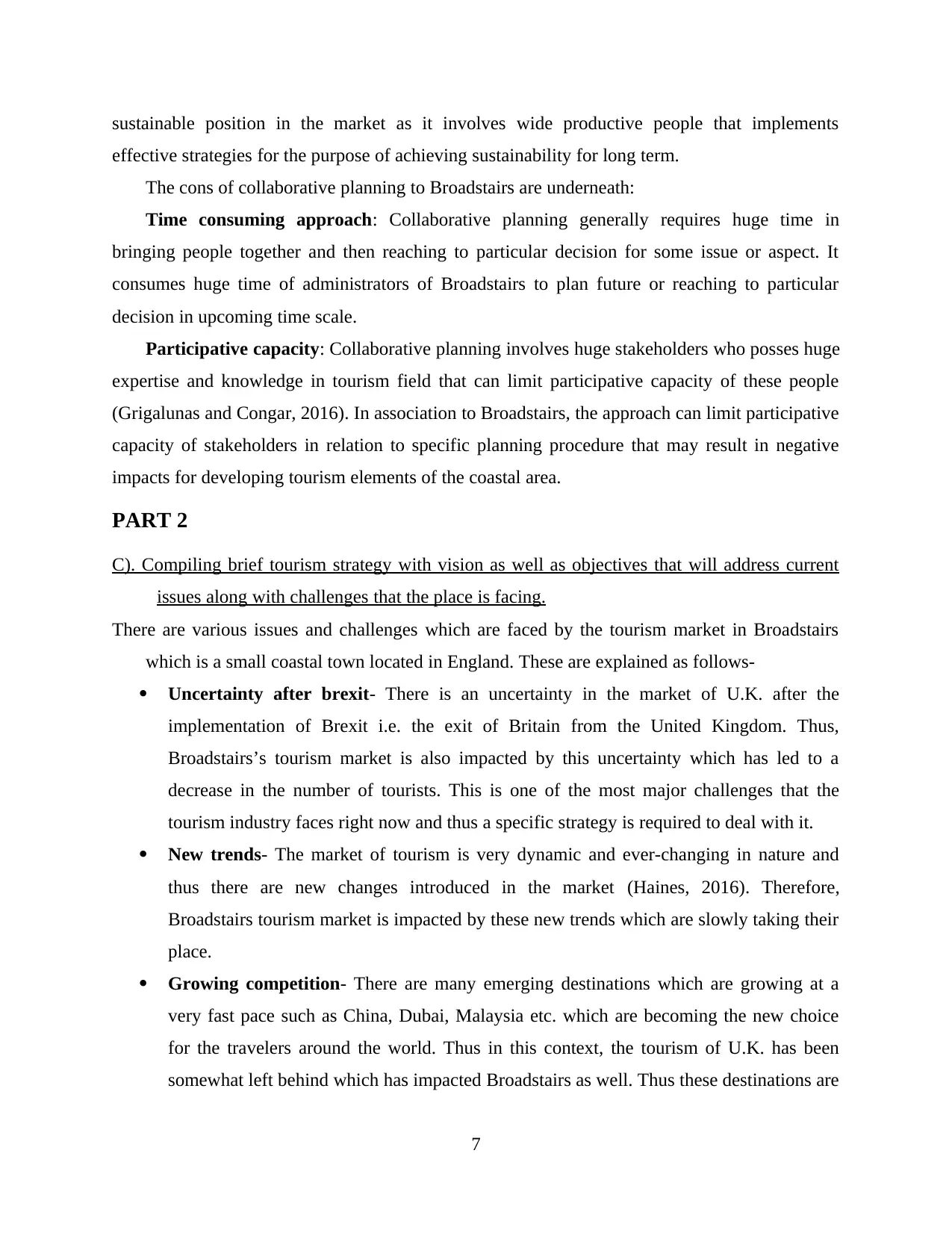
sustainable position in the market as it involves wide productive people that implements
effective strategies for the purpose of achieving sustainability for long term.
The cons of collaborative planning to Broadstairs are underneath:
Time consuming approach: Collaborative planning generally requires huge time in
bringing people together and then reaching to particular decision for some issue or aspect. It
consumes huge time of administrators of Broadstairs to plan future or reaching to particular
decision in upcoming time scale.
Participative capacity: Collaborative planning involves huge stakeholders who posses huge
expertise and knowledge in tourism field that can limit participative capacity of these people
(Grigalunas and Congar, 2016). In association to Broadstairs, the approach can limit participative
capacity of stakeholders in relation to specific planning procedure that may result in negative
impacts for developing tourism elements of the coastal area.
PART 2
C). Compiling brief tourism strategy with vision as well as objectives that will address current
issues along with challenges that the place is facing.
There are various issues and challenges which are faced by the tourism market in Broadstairs
which is a small coastal town located in England. These are explained as follows-
Uncertainty after brexit- There is an uncertainty in the market of U.K. after the
implementation of Brexit i.e. the exit of Britain from the United Kingdom. Thus,
Broadstairs’s tourism market is also impacted by this uncertainty which has led to a
decrease in the number of tourists. This is one of the most major challenges that the
tourism industry faces right now and thus a specific strategy is required to deal with it.
New trends- The market of tourism is very dynamic and ever-changing in nature and
thus there are new changes introduced in the market (Haines, 2016). Therefore,
Broadstairs tourism market is impacted by these new trends which are slowly taking their
place.
Growing competition- There are many emerging destinations which are growing at a
very fast pace such as China, Dubai, Malaysia etc. which are becoming the new choice
for the travelers around the world. Thus in this context, the tourism of U.K. has been
somewhat left behind which has impacted Broadstairs as well. Thus these destinations are
7
effective strategies for the purpose of achieving sustainability for long term.
The cons of collaborative planning to Broadstairs are underneath:
Time consuming approach: Collaborative planning generally requires huge time in
bringing people together and then reaching to particular decision for some issue or aspect. It
consumes huge time of administrators of Broadstairs to plan future or reaching to particular
decision in upcoming time scale.
Participative capacity: Collaborative planning involves huge stakeholders who posses huge
expertise and knowledge in tourism field that can limit participative capacity of these people
(Grigalunas and Congar, 2016). In association to Broadstairs, the approach can limit participative
capacity of stakeholders in relation to specific planning procedure that may result in negative
impacts for developing tourism elements of the coastal area.
PART 2
C). Compiling brief tourism strategy with vision as well as objectives that will address current
issues along with challenges that the place is facing.
There are various issues and challenges which are faced by the tourism market in Broadstairs
which is a small coastal town located in England. These are explained as follows-
Uncertainty after brexit- There is an uncertainty in the market of U.K. after the
implementation of Brexit i.e. the exit of Britain from the United Kingdom. Thus,
Broadstairs’s tourism market is also impacted by this uncertainty which has led to a
decrease in the number of tourists. This is one of the most major challenges that the
tourism industry faces right now and thus a specific strategy is required to deal with it.
New trends- The market of tourism is very dynamic and ever-changing in nature and
thus there are new changes introduced in the market (Haines, 2016). Therefore,
Broadstairs tourism market is impacted by these new trends which are slowly taking their
place.
Growing competition- There are many emerging destinations which are growing at a
very fast pace such as China, Dubai, Malaysia etc. which are becoming the new choice
for the travelers around the world. Thus in this context, the tourism of U.K. has been
somewhat left behind which has impacted Broadstairs as well. Thus these destinations are
7
Paraphrase This Document
Need a fresh take? Get an instant paraphrase of this document with our AI Paraphraser
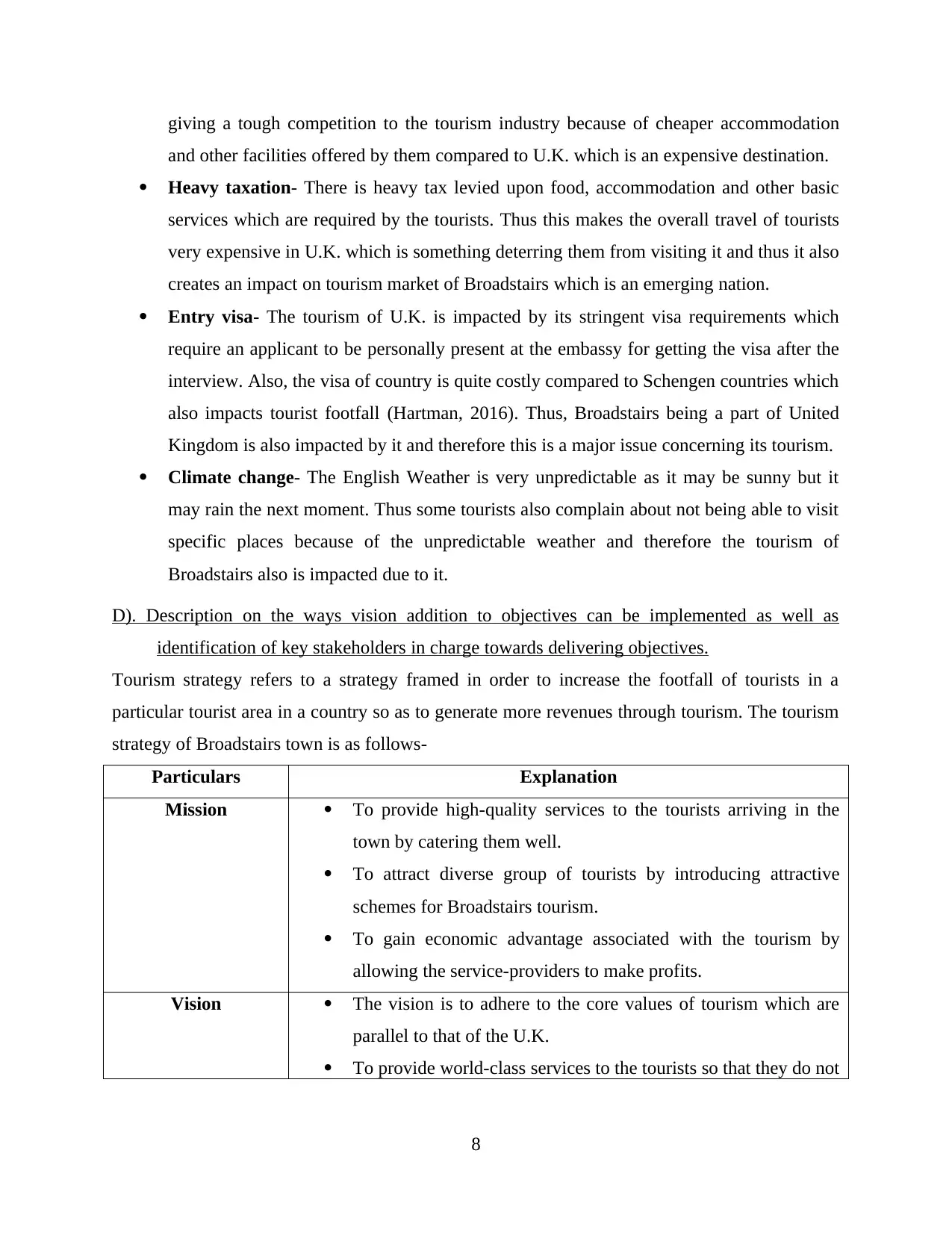
giving a tough competition to the tourism industry because of cheaper accommodation
and other facilities offered by them compared to U.K. which is an expensive destination.
Heavy taxation- There is heavy tax levied upon food, accommodation and other basic
services which are required by the tourists. Thus this makes the overall travel of tourists
very expensive in U.K. which is something deterring them from visiting it and thus it also
creates an impact on tourism market of Broadstairs which is an emerging nation.
Entry visa- The tourism of U.K. is impacted by its stringent visa requirements which
require an applicant to be personally present at the embassy for getting the visa after the
interview. Also, the visa of country is quite costly compared to Schengen countries which
also impacts tourist footfall (Hartman, 2016). Thus, Broadstairs being a part of United
Kingdom is also impacted by it and therefore this is a major issue concerning its tourism.
Climate change- The English Weather is very unpredictable as it may be sunny but it
may rain the next moment. Thus some tourists also complain about not being able to visit
specific places because of the unpredictable weather and therefore the tourism of
Broadstairs also is impacted due to it.
D). Description on the ways vision addition to objectives can be implemented as well as
identification of key stakeholders in charge towards delivering objectives.
Tourism strategy refers to a strategy framed in order to increase the footfall of tourists in a
particular tourist area in a country so as to generate more revenues through tourism. The tourism
strategy of Broadstairs town is as follows-
Particulars Explanation
Mission To provide high-quality services to the tourists arriving in the
town by catering them well.
To attract diverse group of tourists by introducing attractive
schemes for Broadstairs tourism.
To gain economic advantage associated with the tourism by
allowing the service-providers to make profits.
Vision The vision is to adhere to the core values of tourism which are
parallel to that of the U.K.
To provide world-class services to the tourists so that they do not
8
and other facilities offered by them compared to U.K. which is an expensive destination.
Heavy taxation- There is heavy tax levied upon food, accommodation and other basic
services which are required by the tourists. Thus this makes the overall travel of tourists
very expensive in U.K. which is something deterring them from visiting it and thus it also
creates an impact on tourism market of Broadstairs which is an emerging nation.
Entry visa- The tourism of U.K. is impacted by its stringent visa requirements which
require an applicant to be personally present at the embassy for getting the visa after the
interview. Also, the visa of country is quite costly compared to Schengen countries which
also impacts tourist footfall (Hartman, 2016). Thus, Broadstairs being a part of United
Kingdom is also impacted by it and therefore this is a major issue concerning its tourism.
Climate change- The English Weather is very unpredictable as it may be sunny but it
may rain the next moment. Thus some tourists also complain about not being able to visit
specific places because of the unpredictable weather and therefore the tourism of
Broadstairs also is impacted due to it.
D). Description on the ways vision addition to objectives can be implemented as well as
identification of key stakeholders in charge towards delivering objectives.
Tourism strategy refers to a strategy framed in order to increase the footfall of tourists in a
particular tourist area in a country so as to generate more revenues through tourism. The tourism
strategy of Broadstairs town is as follows-
Particulars Explanation
Mission To provide high-quality services to the tourists arriving in the
town by catering them well.
To attract diverse group of tourists by introducing attractive
schemes for Broadstairs tourism.
To gain economic advantage associated with the tourism by
allowing the service-providers to make profits.
Vision The vision is to adhere to the core values of tourism which are
parallel to that of the U.K.
To provide world-class services to the tourists so that they do not
8
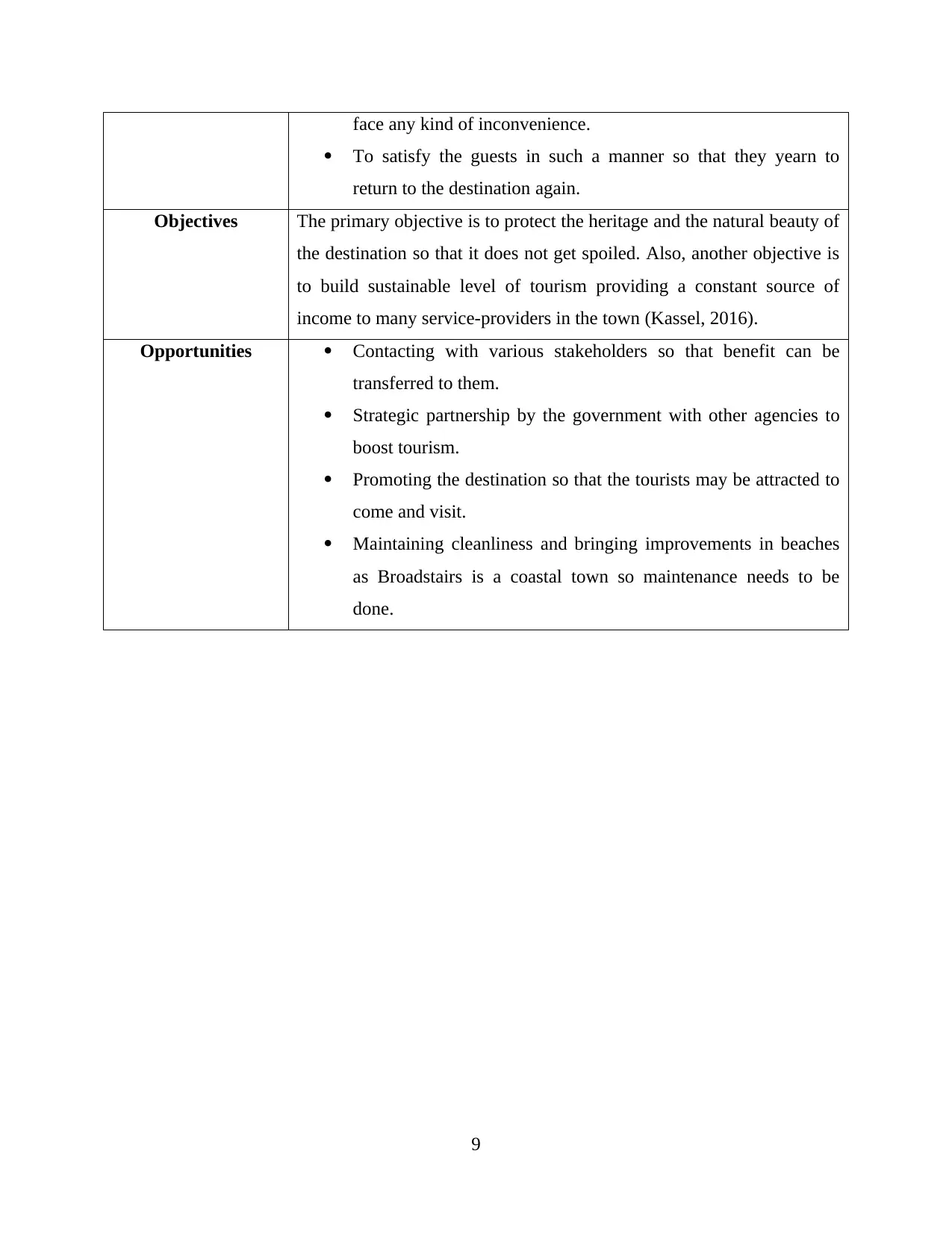
face any kind of inconvenience.
To satisfy the guests in such a manner so that they yearn to
return to the destination again.
Objectives The primary objective is to protect the heritage and the natural beauty of
the destination so that it does not get spoiled. Also, another objective is
to build sustainable level of tourism providing a constant source of
income to many service-providers in the town (Kassel, 2016).
Opportunities Contacting with various stakeholders so that benefit can be
transferred to them.
Strategic partnership by the government with other agencies to
boost tourism.
Promoting the destination so that the tourists may be attracted to
come and visit.
Maintaining cleanliness and bringing improvements in beaches
as Broadstairs is a coastal town so maintenance needs to be
done.
9
To satisfy the guests in such a manner so that they yearn to
return to the destination again.
Objectives The primary objective is to protect the heritage and the natural beauty of
the destination so that it does not get spoiled. Also, another objective is
to build sustainable level of tourism providing a constant source of
income to many service-providers in the town (Kassel, 2016).
Opportunities Contacting with various stakeholders so that benefit can be
transferred to them.
Strategic partnership by the government with other agencies to
boost tourism.
Promoting the destination so that the tourists may be attracted to
come and visit.
Maintaining cleanliness and bringing improvements in beaches
as Broadstairs is a coastal town so maintenance needs to be
done.
9
⊘ This is a preview!⊘
Do you want full access?
Subscribe today to unlock all pages.

Trusted by 1+ million students worldwide
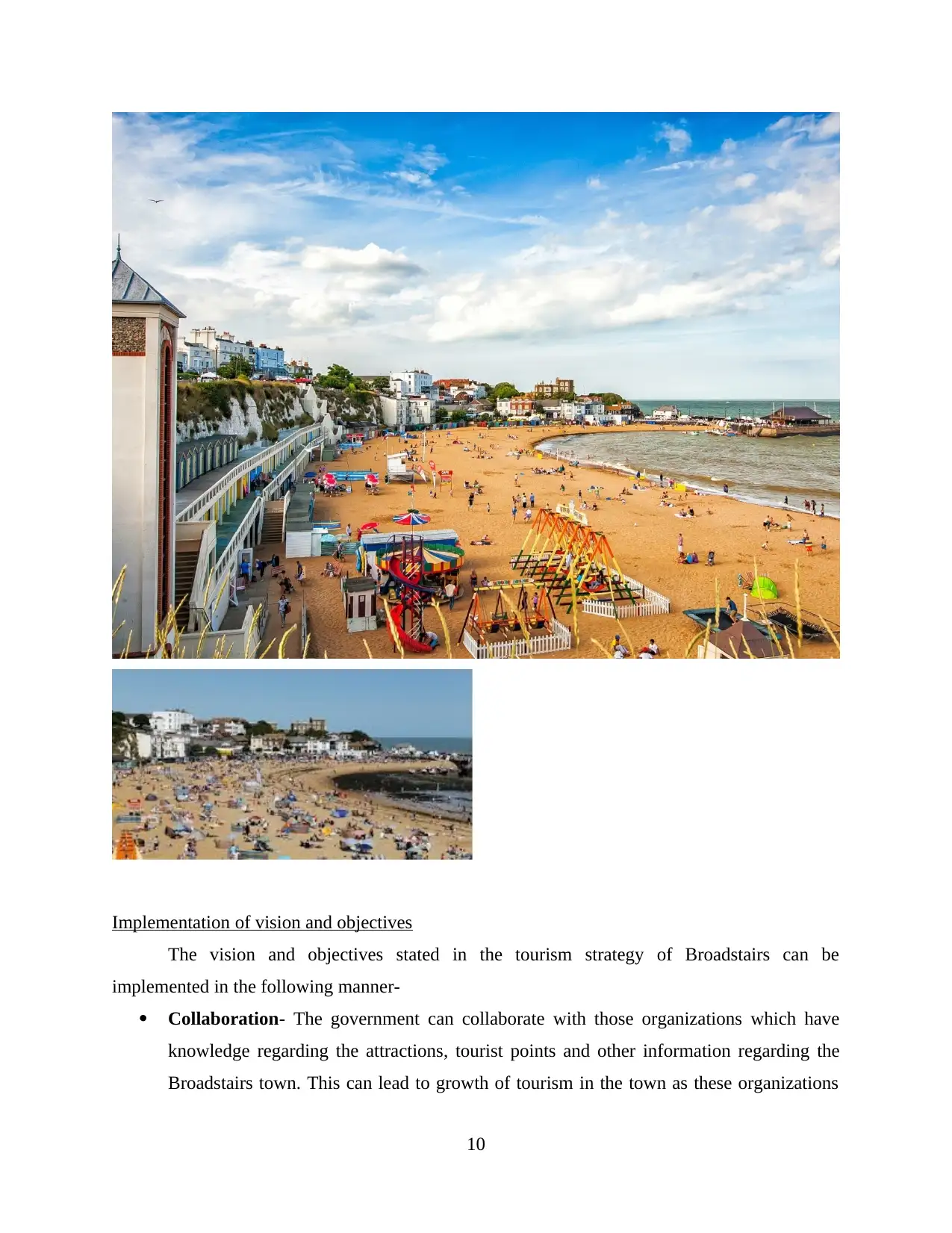
Implementation of vision and objectives
The vision and objectives stated in the tourism strategy of Broadstairs can be
implemented in the following manner-
Collaboration- The government can collaborate with those organizations which have
knowledge regarding the attractions, tourist points and other information regarding the
Broadstairs town. This can lead to growth of tourism in the town as these organizations
10
The vision and objectives stated in the tourism strategy of Broadstairs can be
implemented in the following manner-
Collaboration- The government can collaborate with those organizations which have
knowledge regarding the attractions, tourist points and other information regarding the
Broadstairs town. This can lead to growth of tourism in the town as these organizations
10
Paraphrase This Document
Need a fresh take? Get an instant paraphrase of this document with our AI Paraphraser
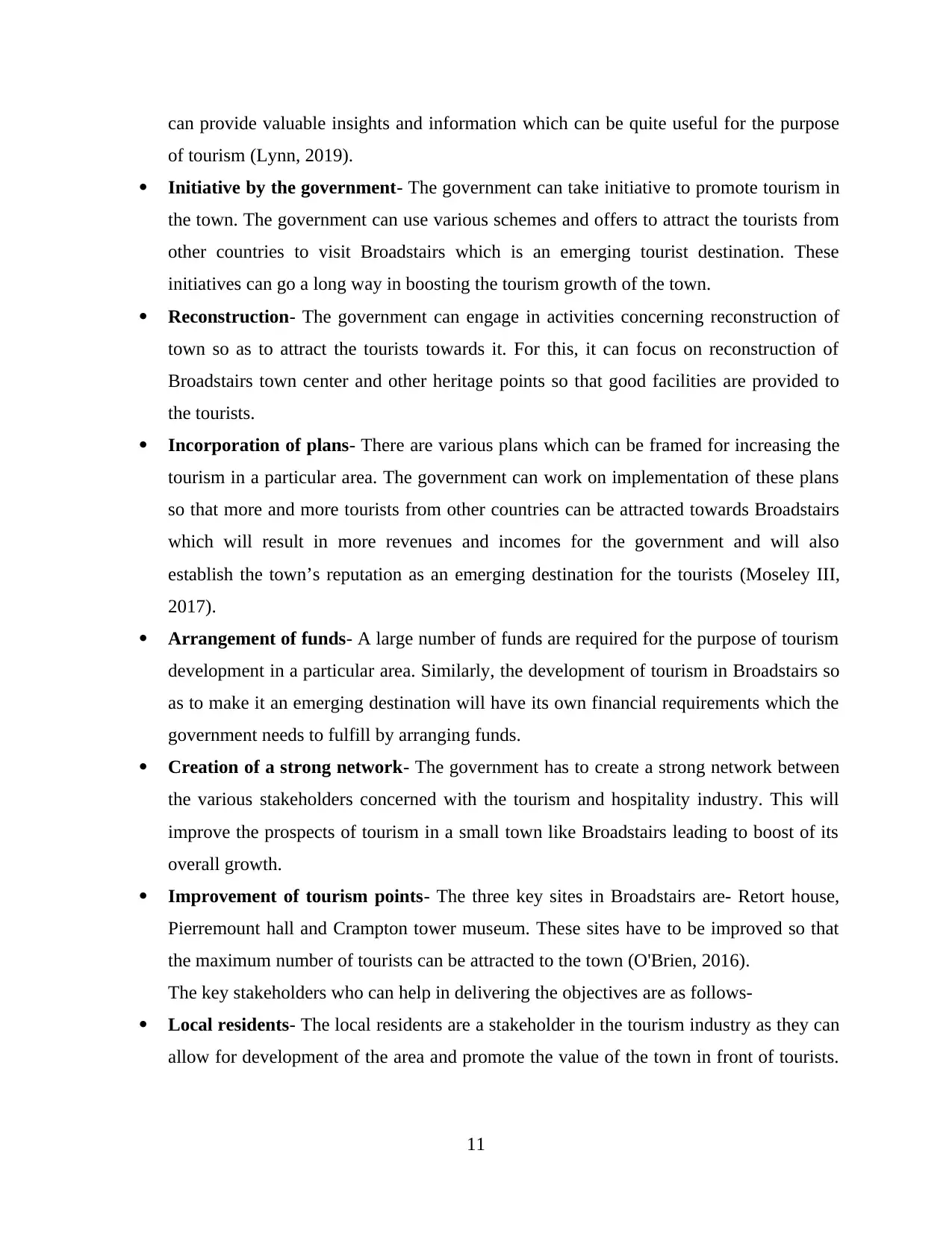
can provide valuable insights and information which can be quite useful for the purpose
of tourism (Lynn, 2019).
Initiative by the government- The government can take initiative to promote tourism in
the town. The government can use various schemes and offers to attract the tourists from
other countries to visit Broadstairs which is an emerging tourist destination. These
initiatives can go a long way in boosting the tourism growth of the town.
Reconstruction- The government can engage in activities concerning reconstruction of
town so as to attract the tourists towards it. For this, it can focus on reconstruction of
Broadstairs town center and other heritage points so that good facilities are provided to
the tourists.
Incorporation of plans- There are various plans which can be framed for increasing the
tourism in a particular area. The government can work on implementation of these plans
so that more and more tourists from other countries can be attracted towards Broadstairs
which will result in more revenues and incomes for the government and will also
establish the town’s reputation as an emerging destination for the tourists (Moseley III,
2017).
Arrangement of funds- A large number of funds are required for the purpose of tourism
development in a particular area. Similarly, the development of tourism in Broadstairs so
as to make it an emerging destination will have its own financial requirements which the
government needs to fulfill by arranging funds.
Creation of a strong network- The government has to create a strong network between
the various stakeholders concerned with the tourism and hospitality industry. This will
improve the prospects of tourism in a small town like Broadstairs leading to boost of its
overall growth.
Improvement of tourism points- The three key sites in Broadstairs are- Retort house,
Pierremount hall and Crampton tower museum. These sites have to be improved so that
the maximum number of tourists can be attracted to the town (O'Brien, 2016).
The key stakeholders who can help in delivering the objectives are as follows-
Local residents- The local residents are a stakeholder in the tourism industry as they can
allow for development of the area and promote the value of the town in front of tourists.
11
of tourism (Lynn, 2019).
Initiative by the government- The government can take initiative to promote tourism in
the town. The government can use various schemes and offers to attract the tourists from
other countries to visit Broadstairs which is an emerging tourist destination. These
initiatives can go a long way in boosting the tourism growth of the town.
Reconstruction- The government can engage in activities concerning reconstruction of
town so as to attract the tourists towards it. For this, it can focus on reconstruction of
Broadstairs town center and other heritage points so that good facilities are provided to
the tourists.
Incorporation of plans- There are various plans which can be framed for increasing the
tourism in a particular area. The government can work on implementation of these plans
so that more and more tourists from other countries can be attracted towards Broadstairs
which will result in more revenues and incomes for the government and will also
establish the town’s reputation as an emerging destination for the tourists (Moseley III,
2017).
Arrangement of funds- A large number of funds are required for the purpose of tourism
development in a particular area. Similarly, the development of tourism in Broadstairs so
as to make it an emerging destination will have its own financial requirements which the
government needs to fulfill by arranging funds.
Creation of a strong network- The government has to create a strong network between
the various stakeholders concerned with the tourism and hospitality industry. This will
improve the prospects of tourism in a small town like Broadstairs leading to boost of its
overall growth.
Improvement of tourism points- The three key sites in Broadstairs are- Retort house,
Pierremount hall and Crampton tower museum. These sites have to be improved so that
the maximum number of tourists can be attracted to the town (O'Brien, 2016).
The key stakeholders who can help in delivering the objectives are as follows-
Local residents- The local residents are a stakeholder in the tourism industry as they can
allow for development of the area and promote the value of the town in front of tourists.
11
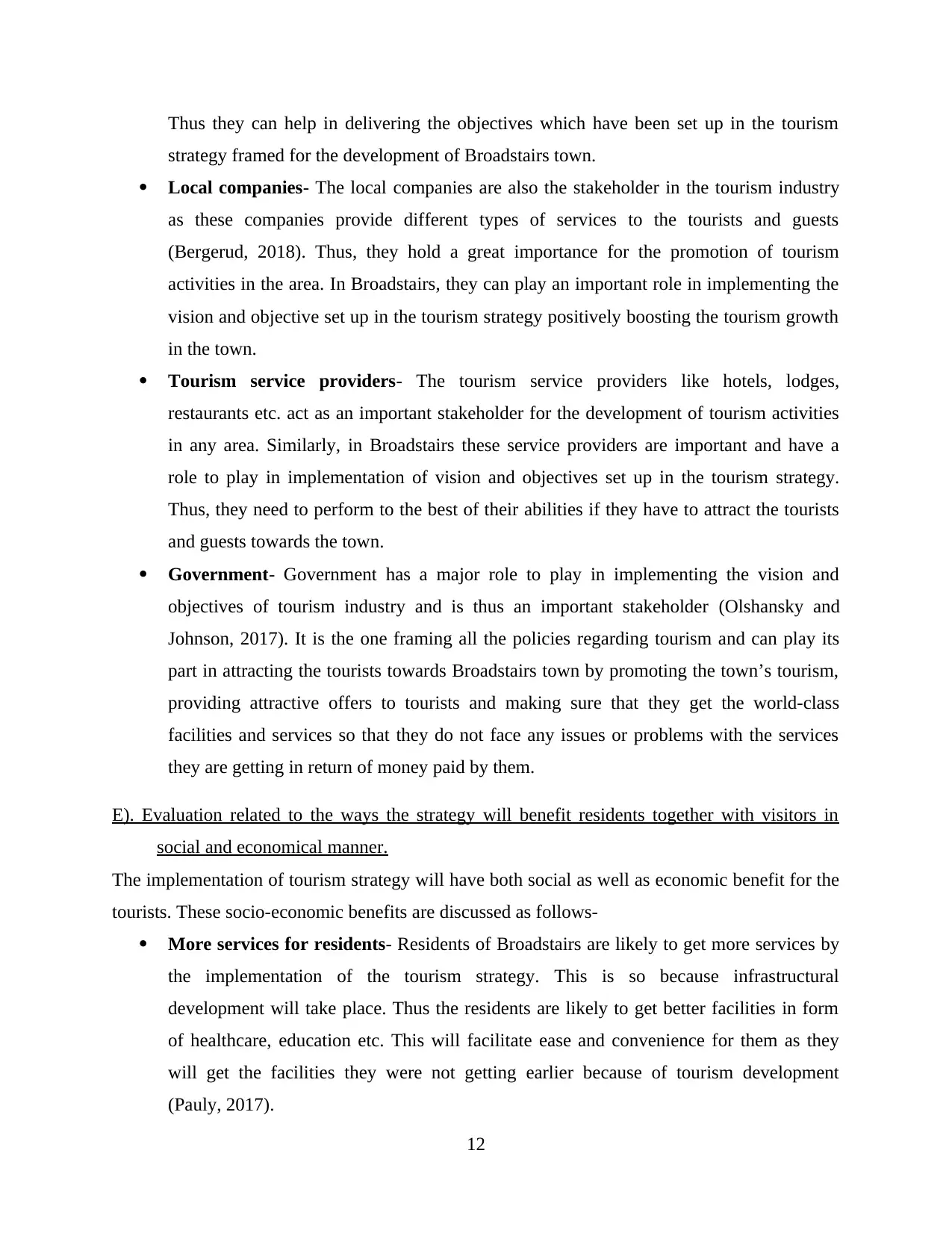
Thus they can help in delivering the objectives which have been set up in the tourism
strategy framed for the development of Broadstairs town.
Local companies- The local companies are also the stakeholder in the tourism industry
as these companies provide different types of services to the tourists and guests
(Bergerud, 2018). Thus, they hold a great importance for the promotion of tourism
activities in the area. In Broadstairs, they can play an important role in implementing the
vision and objective set up in the tourism strategy positively boosting the tourism growth
in the town.
Tourism service providers- The tourism service providers like hotels, lodges,
restaurants etc. act as an important stakeholder for the development of tourism activities
in any area. Similarly, in Broadstairs these service providers are important and have a
role to play in implementation of vision and objectives set up in the tourism strategy.
Thus, they need to perform to the best of their abilities if they have to attract the tourists
and guests towards the town.
Government- Government has a major role to play in implementing the vision and
objectives of tourism industry and is thus an important stakeholder (Olshansky and
Johnson, 2017). It is the one framing all the policies regarding tourism and can play its
part in attracting the tourists towards Broadstairs town by promoting the town’s tourism,
providing attractive offers to tourists and making sure that they get the world-class
facilities and services so that they do not face any issues or problems with the services
they are getting in return of money paid by them.
E). Evaluation related to the ways the strategy will benefit residents together with visitors in
social and economical manner.
The implementation of tourism strategy will have both social as well as economic benefit for the
tourists. These socio-economic benefits are discussed as follows-
More services for residents- Residents of Broadstairs are likely to get more services by
the implementation of the tourism strategy. This is so because infrastructural
development will take place. Thus the residents are likely to get better facilities in form
of healthcare, education etc. This will facilitate ease and convenience for them as they
will get the facilities they were not getting earlier because of tourism development
(Pauly, 2017).
12
strategy framed for the development of Broadstairs town.
Local companies- The local companies are also the stakeholder in the tourism industry
as these companies provide different types of services to the tourists and guests
(Bergerud, 2018). Thus, they hold a great importance for the promotion of tourism
activities in the area. In Broadstairs, they can play an important role in implementing the
vision and objective set up in the tourism strategy positively boosting the tourism growth
in the town.
Tourism service providers- The tourism service providers like hotels, lodges,
restaurants etc. act as an important stakeholder for the development of tourism activities
in any area. Similarly, in Broadstairs these service providers are important and have a
role to play in implementation of vision and objectives set up in the tourism strategy.
Thus, they need to perform to the best of their abilities if they have to attract the tourists
and guests towards the town.
Government- Government has a major role to play in implementing the vision and
objectives of tourism industry and is thus an important stakeholder (Olshansky and
Johnson, 2017). It is the one framing all the policies regarding tourism and can play its
part in attracting the tourists towards Broadstairs town by promoting the town’s tourism,
providing attractive offers to tourists and making sure that they get the world-class
facilities and services so that they do not face any issues or problems with the services
they are getting in return of money paid by them.
E). Evaluation related to the ways the strategy will benefit residents together with visitors in
social and economical manner.
The implementation of tourism strategy will have both social as well as economic benefit for the
tourists. These socio-economic benefits are discussed as follows-
More services for residents- Residents of Broadstairs are likely to get more services by
the implementation of the tourism strategy. This is so because infrastructural
development will take place. Thus the residents are likely to get better facilities in form
of healthcare, education etc. This will facilitate ease and convenience for them as they
will get the facilities they were not getting earlier because of tourism development
(Pauly, 2017).
12
⊘ This is a preview!⊘
Do you want full access?
Subscribe today to unlock all pages.

Trusted by 1+ million students worldwide
1 out of 16
Related Documents
Your All-in-One AI-Powered Toolkit for Academic Success.
+13062052269
info@desklib.com
Available 24*7 on WhatsApp / Email
![[object Object]](/_next/static/media/star-bottom.7253800d.svg)
Unlock your academic potential
Copyright © 2020–2025 A2Z Services. All Rights Reserved. Developed and managed by ZUCOL.




